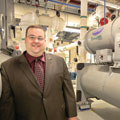
The new Wells Fargo Duke Energy Center is the second-tallest building in downtown Charlotte, N.C.
The massive 1.5-million-sq.-ft., 48-story structure also has some tall aspirations when it comes to its sustainability.
“The building ownership was dedicated to a green project from the very beginning,” saysTeeter Engineering Group, PA’sRichard Bodenheimer, CPD, LEED AP, and the plumbing engineer on the project. “They set the precedent and everyone jumped on board. It was a team effort to determine which green technologies would work with the building.”
This multi-year construction project is highlighted by an intricate three-part water treatment and harvesting system located 100 feet underneath the building’s below-grade parking garage.
This type of green initiative helped Duke Energy Center achieve the U.S. Green Building Council’s highest Leadership in Energy and Environment Design honor - a Platinum certification. Duke Energy Center is the first and tallest high-rise tower to receive USGBC’s highest certification under the LEED for Core & Shell rating system (version 2.0).
Duke Energy Center, part of the Wells Fargo Cultural Campus, is one of many high-rise structures throughout the country that have embraced energy- and water-conserving tactics in recent times.
A structure in the heart of Washington, D.C., simply known as 1200 Nineteenth St., underwent a near complete overhaul and has recently emerged with LEED Platinum status (Core & Shell rating system).
On the other end of the country, San Francisco’s Transamerica Pyramid, featured in numerous movies and commercials over the years, has steadily made upgrades in recent times and earned a LEED Gold rating.
While vastly different in size and function, these three structures all share the common thread of being proactive in reducing their respective carbon footprints.

Major Water Savings
Exactly how much water will Duke Energy Center save?Curt Radkin, Wells Fargo’s senior vice president and development director, says the building is 85% more efficient than traditional building designs.“It equates to about 30 million gallons of water saved per year,” he states.
The majority of that savings comes from the ability to harvest rainwater, groundwater and condensate and then using that treated water for the building cooling tower’s makeup water.
A 140,000-gallon poured-in-place concrete tank sits on level P9 of the building, or some 100 feet underneath the building’s below-grade parking garage. It’s the deepest excavation ever done in downtown Charlotte.
Rainwater harvested from the tower roof and podium green roof and condensate from each mechanical room is pumped into the harvesting tank. Groundwater collected from below the office tower site and from below an adjacent in-city park site with below-grade parking is filtered per local environmental regulations and then piped to the harvesting tank.
The water treatment plant is the brainchild of Chapel Hill, N.C.-basedDr. Roddy Tempest, whose AquaPura systems have been installed worldwide, including in space with NASA in the development of water reuse systems specifically designed for long-duration human space missions. That same technology has been made more terrestrial and is now used at Duke Energy Center.
“It’s a very elaborate treatment plant,” Radkin says. “We’re able to treat up to 95% of the groundwater and then reuse for the cooling tower. It also is designed to reuse cooling tower blow-down water. The whole system has a capacity of treating and re-using over 36 million gallons of water annually. It makes a huge difference.”
Bodenheimer notes the plant has reverse osmosis and media filtration capabilities.
“While the water is in the harvesting tank, ozone is constantly circulating to the tank to discourage bio-growth,” he says. “Once it is put through the harvesting tank, it’s run with another media filtration system and then hit with UV to kill any other growth before it goes to the irrigation systems and the cooling tower makeup.”

Four Tigerflow booster pumps carry water from the harvesting tank to the office cooling tower.
“We’re 100 feet below grade and the cooling towers are located on level 50,” Bodenheimer says. “They are pretty big pumps, about 100 gpm per pump, and each one is probably looking at 300 feet of head. The irrigation system has been up for about eight months now. It has worked almost flawlessly. We’ve never come close to draining the harvesting tank.”
A high-efficiency filtration system is used on the cooling tower evaporation water, he adds. That system filters out chemicals and minerals to allow multiple water passes across the towers, which in turn lowers water usage.
In the general vicinity of that harvesting system are two backup storage tanks that house a supply of domestic water in case a water failure would ever occur in the building.
“Our original projection was we were going to use 36 million gallons with the water harvesting and the low-flow fixtures,” Bodenheimer notes. “We’ve cut that number to about five million. We’re very pleased with how it has turned out.”
Lochinvar electric water heaters are housed on every seven floors, heating that floor and the six floors below it. Hot water is recirculated back to each heater.
“With the office tower, there is no way to vent gas-fired units,” Bodenheimer states. “Because the building is so tall, a central system with all the pumping and piping would be cost-prohibitive.”
In terms of low-flow fixtures, 368 Kohler water closets with Sloan manual dual-flush valves are in the building, along with 92 Sloan waterless urinals and 230 Technical Concepts 0.5 gpm sensor faucets.
“It was one of the most complicated projects I’ve ever worked on, but it was the most fun for that reason,” says Bodenheimer, who adds the building’s core construction, including prefabricated concrete planks for floor perimeter beams and massive core beams, made it challenging to fit in all the MEP systems.
“Not very much on this project was the same thing that we’d done before. The project was complicated but very satisfying.”

Starting From Scratch
The perfect storm of sorts occurred in 2007 for the now 11-story high-rise known as 1200 Nineteenth St., located in Washington’s central business district. Two law firms - the main tenants in the building at the time - were part of mergers and moved out, essentially leaving the building vacant.That allowed internationalreal estate firm Hines, the building’s owner, to engineer a near-complete overhaul of the building (the ground-floor retail section was left intact) that produced the LEED Platinum designation. Part of the redevelopment scope was the installation of new mechanical, electrical and plumbing systems.
Hines has been involved in high-performance real-estate projects dating back to the 1990s and the nascent days of the LEED program. Hines, which added three floors and 93,000 sq. ft. to the building during construction, now has 202 properties in the LEED certification system.
“Green is a big part of the overall value equation,” Hines Global Sustainability ManagerJack Beutellnotes. “There is a lot of marketing hype surrounding it, but there is also real value if it is done right and for the right reasons.”
One of the major upgrades in the building was the replacement of an outdated self-contained, floor-by-floor HVAC system.
“From my understanding, back in the ’80s in this town, it was the system of the day,” says TOLK’sBrian Tanner, P.E., LEED AP, who was the project manager on 1200 Nineteenth St. “It was not the most efficient choice. Self-contained systems can use as much as 1.5 times more energy than a chilled water system. It was time to replace that system.”
Fairfax, Va.-basedTOLK, a consulting engineering firm, and Hines decided to go with a low-temperature, high-efficiency chilled water system operating out of a central plant.
“There are wide differential temperatures in this design that reduce both water and air flow,” Tanner says. “When you widen the delta temperatures, you are pumping less water and blowing less air and you are reducing energy in the building.”

Tanner notes a standard chiller rating is between 44° and 56° F with a 12° Delta T. His goal was to get the system,which features Carrier chillers, Aurora pumps, a BAC cooling tower, Pritchett controls and AirZone air handling units, down in the 40° F range with a Delta T of 16°-18°.
“We want to get colder air on the floor to increase the air-side Delta Ts,” he says. “It’s a trickle-down effect. With this system, you have less sheet-metal costs. Piping costs go down, and it takes less space on the floor. If your air handler is smaller and quieter, you don’t have to build in acoustical treatment in the form of drywall return walls. When you optimize the entire system, there are other positive effects relative to size and acoustics.
“We pushed the envelope. The pumps and the fans are the least-efficient devices on the job. We are trying to minimize the usage of those components and maximize the efficiency of the chiller.”
Individual A.O. Smith water heaters are spaced every two to three floors to go with perimeter electric heating coils within perimeter fan boxes (Nailor), indicative of D.C.’s somewhat mild winter weather.
“This town and market does not have a cold enough season to warrant a boiler and a hot-water system,” Tanner notes. “Three months out of the year it gets cold, but we still have warm days from December through March.”
Tanner says no second thought was given to increasing building efficiencies across the board on this project, including the use of low-flow restroom fixtures (by American Standard, Crane, Kohler, Zurn and Bricor).
“It’s a no-brainer,” he says. “The law says this fixture has to be 1.6 gpm. Let’s go to 1.28. We’ve been pushing this stuff for years. Why not conserve water?”
Low-flow fixtures in the building are projected to save 94,000 gallons of potable water annually.

Efficient Design
San Francisco’s uniquely shaped Transamerica Pyramid has enjoyed added exposure over the years in movies and commercials. Appearances on the big screen have included titles like “Star Trek,” “The Wedding Planner” and “X-Men.”While having a consistent presence in Hollywood, the 48-story building, which was first occupied in 1971 and is located on Montgomery St. in downtown San Francisco, has put into place a sustained game plan over the years aimed squarely at grabbing maximum energy and water savings.
The centerpiece of this movement is a 1 mw combined cooling, heating and power system (two 500-kw Waukesha natural gas-fired V12 engine systems).
With increased costs and reliability concerning with San Francisco’s downtown steam utility, commercial buildings such as Transamerica Pyramid have started to find ways to provide heat in a more reliable and cost-effective manner. Transamerica Pyramid’s CCHP system eliminates the demand for city steam. The building’s electrical load remains the same as before the co-gen system was installed, but the amount of electricity imported from the utility is reduced by about 70% annually.
The vast majority of the combustion heat from the generator goes to power a York absorption chiller. The unit has a 500-ton cooling capacity operating on steam and, in the case of Transamerica Pyramid, a 320-ton capacity utilizing the recovered waste heat from the jacket water and exhaust gas, providing essentially a free source of chilled water.
The chiller is the size of a freight car, which required reinforcement of the basement room floors where it is housed.
“With steam, it’s too hot to dump back into the system, so you add domestic water to cool it,” explains Transamerica Pyramid Construction ManagerDennis Latta. “In a lot of ways, you are wasting water.”
Four Parker Kelly condensing boilers (1.7 million Btu outputs) act as the backup system to heat water.
“The co-generation system is what really streamlined the efficiency of this building,” saysDoug Peterson, the chief engineer of the building. “That was a big home run for us.”
Latta notes the building is projected to save 140,000 gallons of water annually through its green upgrades (low-flow fixtures also figure heavily into the savings). A city park next door, which the property owns, saves 40,000 gallons a month compared to a standard irrigated grass and landscaping baseline mode.
“We’ve gone from an Energy Star score of 84 to a 98,” Latta notes. “All of the activities that have been going on here over the years have been with energy efficiency in mind.”
And that commitment to energy efficiency has placed structures such as Transamerica Pyramid, Duke Energy Center and 1200 Nineteenth St. in a rapidly growing category of green high-rises focused on environmentally sound design and operation.
